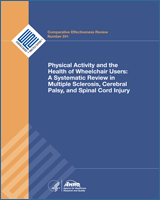NCBI Bookshelf. A service of the National Library of Medicine, National Institutes of Health.
Selph SS, Skelly AC, Wasson N, et al. Physical Activity and the Health of Wheelchair Users: A Systematic Review in Multiple Sclerosis, Cerebral Palsy, and Spinal Cord Injury [Internet]. Rockville (MD): Agency for Healthcare Research and Quality (US); 2021 Oct. (Comparative Effectiveness Review, No. 241.)

Physical Activity and the Health of Wheelchair Users: A Systematic Review in Multiple Sclerosis, Cerebral Palsy, and Spinal Cord Injury [Internet].
Show detailsTable H-1. Strength of evidence for Key Question 2: aerobic exercise for multiple sclerosis (MS Word, 58K)
Table H-2. Strength of evidence for Key Question 2: aerobic exercise for cerebral palsy (MS Word, 56K)
Table H-3. Strength of evidence for Key Question 2: aerobic exercise for cerebral palsy and multiple sclerosis (MS Word, 46K)
Table H-4. Strength of evidence for Key Question 2: aerobic exercise for spinal cord injury (MS Word, 50K)
Table H-5. Strength of evidence for Key Question 2: balance exercise for multiple sclerosis (MS Word, 60K)
Table H-6. Strength of evidence for Key Question 2: balance exercise for cerebral palsy (MS Word, 52K)
Table H-7. Strength of evidence for Key Question 2: balance exercise for spinal cord injury (MS Word, 44K)
Table H-8. Strength of evidence for Key Question 2: muscle strength exercise for multiple sclerosis (MS Word, 49K)
Table H-9. Strength of evidence for Key Question 2: muscle strength exercise for cerebral palsy (MS Word, 48K)
Table H-10. Strength of evidence for Key Question 2: muscle strength exercise for spinal cord injury (MS Word, 43K)
Table H-11. Strength of evidence for Key Question 2: multimodal exercise that includes strengthening for multiple sclerosis (MS Word, 51K)
Table H-12. Strength of evidence for Key Question 2: multimodal exercise that includes strengthening for cerebral palsy (MS Word, 47K)
Table H-13. Strength of evidence for Key Question 2: multimodal exercise that includes strengthening for spinal cord injury (MS Word, 44K)
Table H-14. Strength of evidence for Key Question 2a clinical outcomes: mental health (MS Word, 45K)
Table H-15. Strength of evidence for Key Question 2: general exercise effect across interventions and populations (MS Word, 51K)
Table H-18. Strength of evidence for Key Question 2c: reduction of harms of immobility (MS Word, 43K)
Table H-20. Strength of evidence for Key Question 2e: harms of physical activity (MS Word, 44K)
- Strength of Evidence - Physical Activity and the Health of Wheelchair Users: A S...Strength of Evidence - Physical Activity and the Health of Wheelchair Users: A Systematic Review in Multiple Sclerosis, Cerebral Palsy, and Spinal Cord Injury
Your browsing activity is empty.
Activity recording is turned off.
See more...